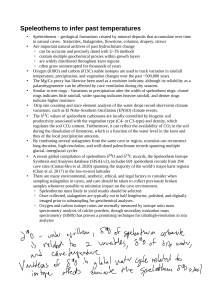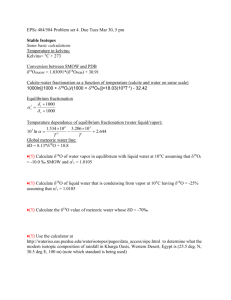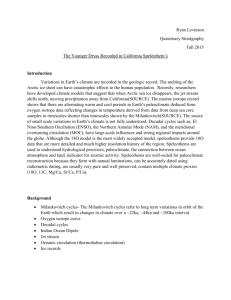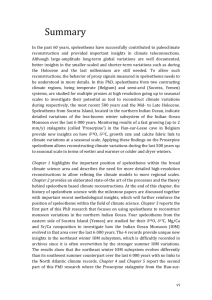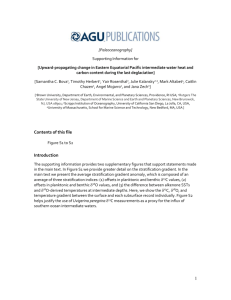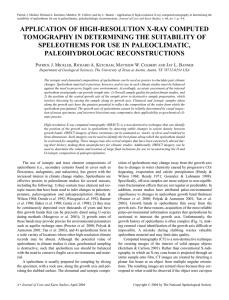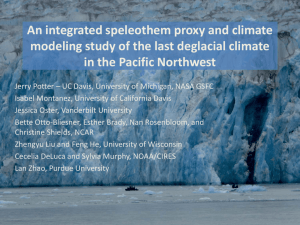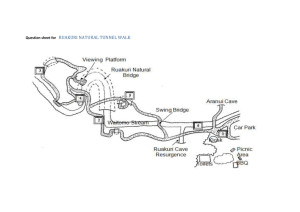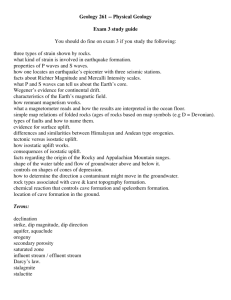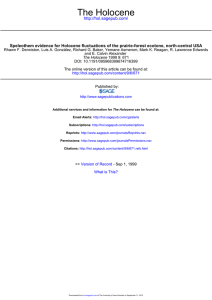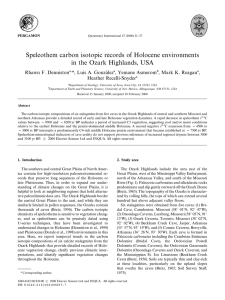Interpreting trace-metal and stable isotopic results from a Holocene
advertisement
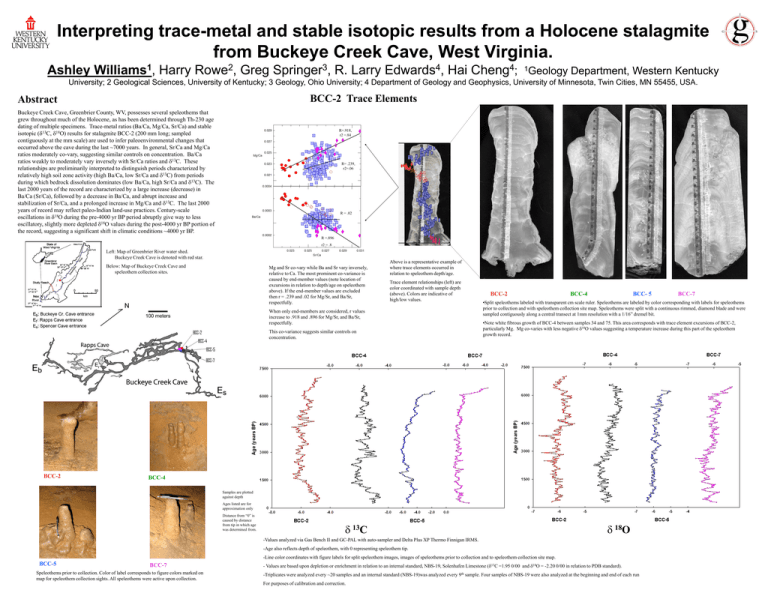
Interpreting trace-metal and stable isotopic results from a Holocene stalagmite from Buckeye Creek Cave, West Virginia. Ashley 1 Williams , Harry 2 Rowe , Greg 3 Springer , R. Larry 4 Edwards , Hai 4 Cheng ; 1Geology Department, Western Kentucky University; 2 Geological Sciences, University of Kentucky; 3 Geology, Ohio University; 4 Department of Geology and Geophysics, University of Minnesota, Twin Cities, MN 55455, USA. BCC-2 Trace Elements Abstract Buckeye Creek Cave, Greenbrier County, WV, possesses several speleothems that grew throughout much of the Holocene, as has been determined through Th-230 age dating of multiple specimens. Trace-metal ratios (Ba/Ca, Mg/Ca, Sr/Ca) and stable isotopic (13C, 18O) results for stalagmite BCC-2 (200 mm long; sampled contiguously at the mm scale) are used to infer paleoenvironmental changes that occurred above the cave during the last ~7000 years. In general, Sr/Ca and Mg/Ca ratios moderately co-vary, suggesting similar controls on concentration. Ba/Ca ratios weakly to moderately vary inversely with Sr/Ca ratios and 13C. These relationships are preliminarily interpreted to distinguish periods characterized by relatively high soil zone activity (high Ba/Ca, low Sr/Ca and 13C) from periods during which bedrock dissolution dominates (low Ba/Ca, high Sr/Ca and 13C). The last 2000 years of the record are characterized by a large increase (decrease) in Ba/Ca (Sr/Ca), followed by a decrease in Ba/Ca, and abrupt increase and stabilization of Sr/Ca, and a prolonged increase in Mg/Ca and 13C. The last 2000 years of record may reflect paleo-Indian land-use practices. Century-scale oscillations in 18O during the pre-4000 yr BP period abruptly give way to less oscillatory, slightly more depleted 18O values during the post-4000 yr BP portion of the record, suggesting a significant shift in climatic conditions ~4000 yr BP. R=.918, r2 =.84 R= .239, r2=.06 R = .02 R =.896 r2 = .8 Left: Map of Greenbrier River water shed. Buckeye Creek Cave is denoted with red star. Below: Map of Buckeye Creek Cave and speleothem collection sites. Mg and Sr co-vary while Ba and Sr vary inversely, relative to Ca. The most prominent co-variance is caused by end-member values (note location of excursions in relation to depth/age on speleothem above). If the end-member values are excluded then r = .239 and .02 for Mg/Sr, and Ba/Sr, respectfully. Above is a representative example of where trace elements occurred in relation to speleothem depth/age. Trace element relationships (left) are color coordinated with sample depth (above). Colors are indicative of high/low values. When only end-members are considered, r values increase to .918 and .896 for Mg/Sr, and Ba/Sr, respectfully. This co-variance suggests similar controls on concentration. BCC-2 BCC-2 BCC-4 BCC- 5 •Split speleothems labeled with transparent cm scale ruler. Speleothems are labeled by color corresponding with labels for speleothems prior to collection and with speleothem collection site map. Speleothems were split with a continuous rimmed, diamond blade and were sampled contiguously along a central transect at 1mm resolution with a 1/16” dremel bit. •Note white fibrous growth of BCC-4 between samples 34 and 75. This area corresponds with trace element excursions of BCC-2, particularly Mg. Mg co-varies with less negative 18O values suggesting a temperature increase during this part of the speleothem growth record. BCC-4 Samples are plotted against depth Ages listed are for approximation only Distance from “0” is caused by distance from tip in which age was determined from. 13C 18O -Values analyzed via Gas Bench II and GC-PAL with auto-sampler and Delta Plus XP Thermo Finnigan IRMS. -Age also reflects depth of speleothem, with 0 representing speleothem tip. -Line color coordinates with figure labels for split speleothem images, images of speleothems prior to collection and to speleothem collection site map. BCC-5 BCC-7 Speleothems prior to collection. Color of label corresponds to figure colors marked on map for speleothem collection sights. All speleothems were active upon collection. - Values are based upon depletion or enrichment in relation to an internal standard, NBS-19, Solenhafen Limestone (13C =1.95 0/00 and 18O = -2.20 0/00 in relation to PDB standard). -Triplicates were analyzed every ~20 samples and an internal standard (NBS-19)was analyzed every 9th sample. Four samples of NBS-19 were also analyzed at the beginning and end of each run For purposes of calibration and correction. BCC-7 Process Sample Data 1. Collect speleothem-Use rock hammer to chip away from base. 2. Record environmental conditions at time of collection. Eg. Drip source, temperature, elevation, CO2. 3. Split speleothem using a continuous-rimmed diamond blade. 4. Using a dremel tool, drill speleothem contiguously at one mm resolution along a central transect. 5. Contain sample in micro-centrifuge tubes labeled according to sample number. 6. Using a microbalance, weigh samples into 0.40-0.50 mg for isotope analysis and 3.00-3.50 mg for trace element analysis. Trace Elements 7. Create mixed metal standard using calibrated single element standards, purchased from CPI, Inc. 8. Samples are analyzed with Varian Vista Pro ICP-OES: Flow; 1.05 ml/min Power; .90 kw 10.Wavelengths are measured in relation to the wavelengths emitted by the standards in order to determine which elements are present: •Ca (430.253 nm) •Ba (493.408 nm) •Mg (279.553 nm) Conclusions: Mixed metal standards are positioned in first row. •Sr (421.552 nm) • A significant shift in regional climate is thought to have occurred at ~4000 years BP due to century-scale oscillations in 18O values which abruptly give way to stabilized, more depleted values possibly caused by PaleoIndian land use. • Sr/Ca and Mg/Ca ratios co-vary, suggesting similar controls on concentration. End-member values suggest a stronger covariance between the two caused by a significant increases in Sr and Mg ratios at ~1224 yrs BP to ~2700 yrs BP and then again at ~6480 yrs BP. These values also co-vary with 13C values, suggesting that concentrations were affected by vegetation above the cave. Standards • Ba/Ca varies inversely with 13C, suggesting periods of high soil zone activity to periods of predominant dissolution of bedrock above the cave. Samples • The last 2000 years of the record are characterized by a large increase in Ba/Ca followed by a decrease in Sr/Ca, followed by a decrease in Ba/Ca and an abrupt increase and stabilization of Sr/Ca with a prolonged increase in Mg/Ca and 13C. Trace elements being measures along with standards Future Plans: Isotopes During the next year, CO2 levels in Buckeye Creek Cave will be closely monitored along with temperature and drip water concentrations in order to establish a modern calibration for the samples. Several other previously collected samples will be analyzed via the same means in order to better constrain paleo-environmental changes of the region throughout the Holocene. 7 Put measured samples into glass test tubes. 8. Purge with Helium ~2 min per sample. 9.Acidify each sample with 0.2 ml of 100% Phosphoric Acid via a syringe. 10. Allow to equilibrate for 12 hours at 60 Degrees C. Acknowledgements: 11.Samples are analyzed via Gas Bench II with GC-PAL auto-sampler and Delta Plus XP Thermo Finnigan IRMS against an internal standard, NBS-19. • Bob King for help with sample preparation and analytical equipment use. • Daniel Hawkins and Kelley Reynolds for much support. • Special thanks to Dr. Andrew H. Wulff for making this project possible. References 1. J.C.Hellstrom and M.T. McCulloch.” Multi-proxy constraints on the climatic significance of trace element records from a new Zealand speleothem”.9 April 2000. Earth and Planetary Science Letters 179 (2000) 287-297. Inside Gas Bench II 2. Denniston, et al. “Evidence for increased cool season moisture during the middle Holocene”. Geology. September 1999. v. 27. no.9. p.858-818. 3. L.A.Gonzalez, et al. “ Inorganic Calcite Morphology: Roles Of Fluid Chemistry and Fluid Flow”. Journal of Sedimentary Petrology. Vol. 62. No.3. May, 1992. p.382-399.
